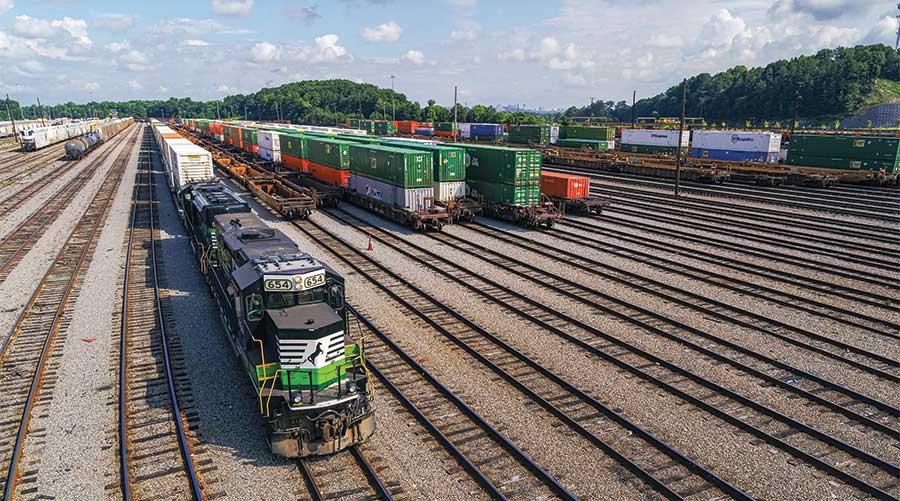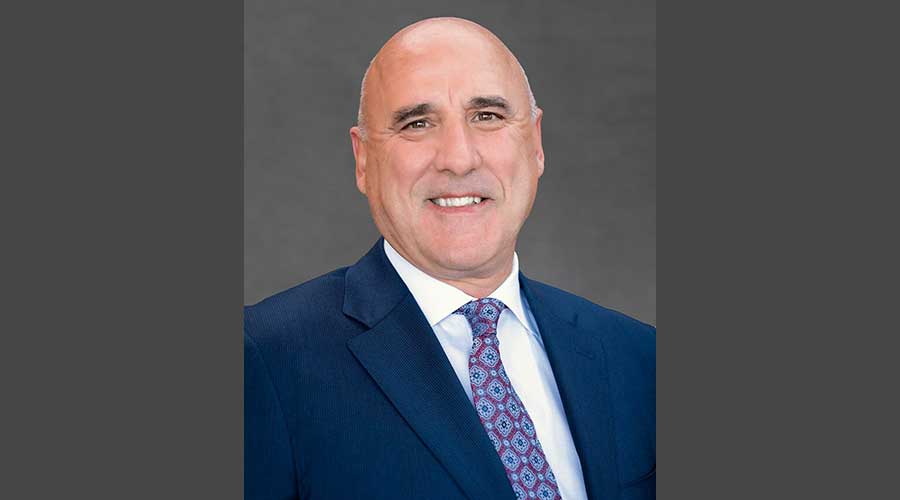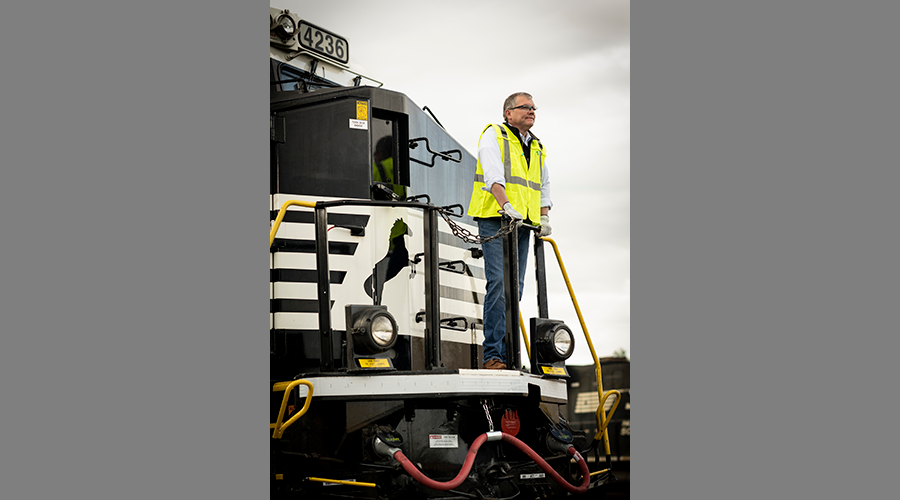Stay updated on news, articles and information for the rail industry
November 2009
Rail News: Norfolk Southern Railway
If funding falls into place, so will Norfolk Southern's Crescent Corridor
For more than a decade, the commonwealth of Virginia has sought to add lanes to Interstate 81 to relieve heavy truck congestion. The 846-mile highway stretches 323 miles in Virginia — the longest I-81 segment in any state.
Virginia most recently considered a plan to add two lanes to the interstate commonwealth-wide. To be funded by tolls, the project would cost about $13 billion over 20 years.
Norfolk Southern Corp. believes it has a better — and cheaper — option for reducing highway traffic. And not only in Virginia, but in 12 other states, as well. The Class I is pursuing the Crescent Corridor, a more than $2 billion initiative aimed at developing a 2,500-mile domestic intermodal route along existing lines between New Jersey and Louisiana.
First proposed in July 2007, the corridor would be the single-largest addition of new freight transportation capacity in the nation since the interstate system was developed in the 1960s, according to NS.
To be funded through a public-private partnership (PPP) between the Class I, federal government and 13 states (including the core states of Alabama, Mississippi, Pennsylvania, Tennessee and Virginia), the corridor would be established by building five and expanding six intermodal terminals; constructing 300 miles of double track and passing sidings; straightening curves; and adding signals.
By 2012, trucks will account for more than 20 percent of traffic on many gridlocked highways, according to NS. If the Class I can get all constituents on board and all plans in place, the corridor each year would divert about 1 million long-haul trucks from 10 interstates, including highly congested I-81, I-40 and I-59. Currently, only about 5 percent of freight moving along the route between the Southeast and Northeast travels by rail.
"The great thing about this corridor is that it addresses the last major freight flow in the nation where intermodal is not making significant headway," says NS Chairman, President and Chief Executive Officer Wick Moorman. "The corridor is at the real epicenter of congestion, especially I-81 and I-40, where highways are handling three to four times the trucks they're designed for. This is a big opportunity for truck to rail."
The Crescent Corridor also poses an opportunity for NS to bolster its domestic intermodal traffic by as many as 1.3 million loads annually, generating hundreds of millions of dollars in revenue in the process. The route also is projected to spark numerous business development opportunities for the Class I.
For the 13 states and dozens of communities, the corridor promises to provide public benefits beyond truck diversions, such as the creation of 47,000 jobs by 2020 and 73,000 jobs by 2030; reduction of carbon emissions by about 2 million tons annually; and drop in fuel consumption by about 170 million gallons each year. Plus, highway maintenance costs would drop by $92 million and tax revenue generation would total about $326 million, according to NS.
"The numbers show a compelling case to do the corridor," says Moorman. "We want to get it done quickly so the benefits start flowing quickly."
Corridor at a Cost
But the large-scale project has a huge price tag, more than half of which would need to be covered by public partners. It'll take a monumental effort from NS execs to convince the federal and state governments to pony up hundreds of millions of dollars before the Class I can get the Crescent Corridor rolling. Many transportation and rail projects nationwide — including multi-billion-dollar PPPs such as CSX Corp.'s National Gateway and Chicago's CREATE — also are seeking government dollars in the stimulus era, so the competition is fierce.
So far, Virginia has provided $45 million for the Crescent and some work in the commonwealth has been completed or is under way, and Pennsylvania has committed $27 million in its 2009-2010 budget as well as an additional $30 million proposed through the Rail Transportation Assistance Capital Bond program.
Because returns on intermodal traffic aren't as high compared with other commodities, NS couldn't justify the total investment to fund the corridor itself, says Executive Vice President of Law and Corporate Relations James Hixon.
While lobbying for funding, NS execs also are trying to buck some not-in-my-backyard resistance in several communities to planned terminal sites. The public perception of a terminal is closer to a noisy and dirty hump yard than a modern, high-tech intermodal facility, execs say.
To address residents' concerns, NS is holding public meetings to review a terminal's design and function.
By stressing the Crescent's benefits, the railroad can win over skeptics, Hixon believes. The main advantage: The corridor offers a 25-to-1 benefit-to-cost ratio over 30 years, he says.
Last month, NS launched a Web site, TheFutureNeedsUs.com, to extol the project's virtues. The site also promotes the Class I's other PPP projects, including the Heartland Corridor, a double-stack intermodal route through Virginia, West Virginia and Ohio that's well under way.
"We think that with highway congestion as it is, and with concerns about the environment and diesel costs, which will go back up eventually, the timing of the Crescent Corridor is in our favor," says Hixon.
Stimulus an Impetus
The time to put a hand out for federal transportation funding — especially of the stimulus variety — is at a favorable point, too. In September, NS and the states of Alabama, Mississippi, Pennsylvania, Tennessee and Virginia submitted an application to the U.S. Department of Transportation (USDOT) seeking a $300 million Transportation Investment Generating Economic Recovery (TIGER) program grant for the Crescent. The TIGER program is funded through the American Recovery and Reinvestment Act.
The partners believe they can land a chunk of the $1.5 billion available in TIGER grants — despite competition with nearly 1,400 other applicants — because their project can meet the USDOT's award criteria, namely by significantly impacting the nation and a major region, and creating jobs, says Hixon.
In addition, the multi-phased corridor's first phase could be completed by the USDOT's deadline of February 2012. The phase would include new terminals in Rossville, Tenn., near Memphis; McCalla, Ala., near Birmingham; and Greencastle, Pa. NS selected sites for those facilities in the past few months.
The work also calls for expanding terminals in Philadelphia and Harrisburg, Pa., and completing various track improvements, such as the construction of 10 passing sidings, 557 individual track-speed upgrades and replacement of rail along 393 miles of track.
The three new terminals — which will anchor the corridor — will provide the most immediate returns on investment, says VP of Business Development Rob Martinez.
NS plans to eventually introduce 28 new trains on the corridor, including 10 trains in the first phase. New or improved services would begin rolling out in 2011.
Lengths of haul along the corridor likely will average about 1,000 miles and trains will seek to average 500 miles per 24-hour period, matching single-driver trucks. Transit times are projected to be about 43.3 hours between Memphis and Philadelphia and 30 hours between eastern Tennessee and New Jersey.
"The corridor has to be transit-time and performance sensitive — performance has to be high to compete with trucks," says Martinez.
Currently, intermodal retains an 80 percent marketshare of freight moving between Los Angeles and Chicago, and 50 percent marketshare of moves between Chicago and New York City, he says.
With 95 percent of freight currently moving by truck along the Crescent Corridor, the project offers "vast potential" for traffic in north-south lanes if rail can provide truck-like service, says Martinez.
NS is hoping TheFutureNeedsUs Web site can help promote that potential to shippers. In addition, the site will impress upon the public rail's benefits in general, says Martinez.
"There's a very poor understanding of how freight moves in the United States, to the detriment of transportation policy," he says.
Along the Learning Curve
NS senior execs are hoping the Class I's positive experience with the Heartland Corridor public-private partnership — including federal and state government participation — will not only help sway UDSOT officials' ruling on the TIGER grant application, but attract federal funds for the Crescent in the next surface transportation bill.
NS landed funds for the 531-mile Heartland Corridor from three states and the most recent federal transportation bill, SAFETEA-LU. The corridor, which includes new terminals in Elliston, Va., Columbus, Ohio, and Prichard, W.Va., will shave about 250 miles off NS' existing intermodal route between Virginia ports and the Midwest.
To be finished in mid-2010, the Heartland Corridor is one of only a few projects funded by SAFETEA-LU that will reach completion, says Hixon.
"Others still are on the drawing board," he says.
The Heartland project was a PPP learning experience that will pay dividends with Crescent Corridor planning and execution, says CEO Moorman.
"It helped us figure out how to work with the federal government and states, and how to pursue a large project together," he says. "We also learned how to work through the process."
Something old, something new
One key lesson: incorporate existing terminals and track as much as possible to rein in the Crescent Corridor's costs and maximize current capacity.
"We want to leverage as many existing facilities and as much infrastructure as we have," says NS VP of Intermodal and Automotive Marketing Mike McClellan.
In addition to building the three anchor terminals, as well as ones in the Charlotte, N.C., and Knoxville, Tenn., areas, the Class I plans to upgrade six existing terminals, including those in New Orleans, Atlanta, Bethlehem, Pa., and Croxton, N.J.
NS also will upgrade hundreds of miles of track and other infrastructure to accommodate higher train speeds and boost capacity.
In terms of new construction, the railroad will concentrate double track, siding and other trackwork between Riverton Junction in Front Royal, Va., and Harrisburg, Pa., where traffic flow on the corridor is projected to be heavy.
The Class I already completed four corridor projects in Virginia between November 2008 and March 2009: passing track extensions between Belvoir and The Plains, and between Linden and Riverton Junction; new traffic controls between Manassas and the junction; and double track and a single crossover in Cedarville.
NS currently is working on a passing track extension in Gainesville that's scheduled for completion by year's end.
Next year, the Class I expects to start construction on Riverton Junction connection tracks in Front Royal, a passing track extension in Berryville and a new passing siding in Elkton.
If NS obtains federal dollars, the railroad also would begin to enlarge a track bore at the Montgomery Tunnel between Shawsville and Christiansburg to accommodate double-stack trains.
Purely a Domestic Play
After the Crescent Corridor is entirely in place — a completion date hasn't been determined because the project will advance as funding and market demand dictates, senior execs say — the route predominantly will handle domestic container traffic.
But about 10 percent to 20 percent of the traffic will be domestic trailers, says McClellan.
Although international intermodal traffic has been down so far in 2009, and the nation is "going through the worst freight period in my 20 years in the industry," domestic intermodal traffic is holding up well, he says.
"Dry van domestic truck volume is down about 16 percent," says McClellan.
Trucks currently have competitive rates and open capacity, which favor the mode over rail in some cases. But a market correction usually follows a period of trucking prosperity, says McClellan.
"We have the ability to chew into trucks' share," he says. "We can offer a lower-cost transportation alternative to shippers, and help them be more competitive."
Other Roads On Board
NS expects to gain an assist from several other railroads along the corridor to provide that alternative, including the Philadelphia, Bethlehem & New England Railroad in Bethlehem; Canadian Pacific in New England per a haulage agreement; and Pan Am Railways Inc. in New England as part of the Pan Am Southern L.L.C./Patriot Corridor initiative.
If the TIGER grant pans out, shippers will be able to tap into at least a crucial portion of the Crescent Corridor in the New England area come 2012.
With a heightened awareness of air quality, fuel consumption, highway congestion and traffic safety in the nation, it's a good thing the Class I didn't postpone the development of the corridor for a few years because of the weak economy and an uncertain funding climate, senior execs say.
"Ten to 15 years from now, we don't want to be kicking ourselves for not getting this done," says EVP Hixon.
NS hasn't been sitting back and hoping the corridor comes to fruition some day," says Moorman.
"We've been working at this for a long time," he says. "It addresses issues that won't go away."
Sustaining Momentum
For now, the Class I will continue trying to get the word out on both national and state levels that the corridor is the best option for addressing highway congestion and transportation-related environmental concerns between New Jersey and Louisiana, as well as establishing a vital intermodal route for shippers. There already are a number of key constituents in NS' corner, such as several governors, mayors and shippers.
"Moving freight off our highways eases congestion and saves pavement wear and tear," said Pennsylvania Gov. Ed Rendell in a statement issued in February, when the state committed funds to the corridor.
So far, no one has said the Crescent isn't a good idea, says Moorman — a factor NS hopes to exploit to secure funding and get loads flowing ASAP.
"When it's a question if people want this traffic on a truck or train, they're all enthusiastic that they want it on trains," he says.
The message that rail is the friendliest of modes to the environment and a major reliever to gridlocked highways is one the entire rail industry has been trying to drive home — and take advantage of — for some time. The corridor can serve as a poster child for the future of U.S. transportation and rail's role in it, a status that can't help but make the Crescent a reality, and soon, Moorman believes.
"This is the way to address freight in this nation, and in a very sustainable and efficient way," he says.


 2025 MOW Spending Report: Passenger-rail programs
2025 MOW Spending Report: Passenger-rail programs
 Gardner steps down as Amtrak CEO
Gardner steps down as Amtrak CEO
 Guest comment: Oliver Wyman’s David Hunt
Guest comment: Oliver Wyman’s David Hunt
 Women of Influence in Rail eBook
Women of Influence in Rail eBook
 railPrime
railPrime








